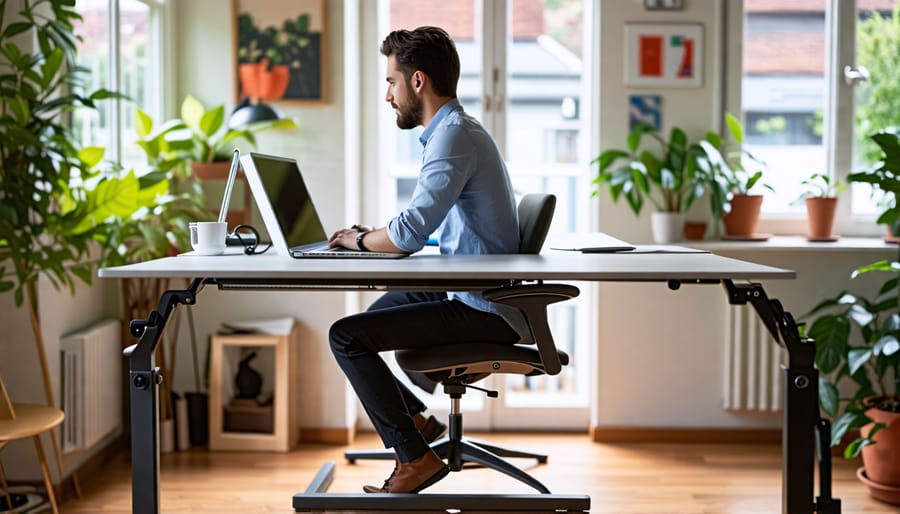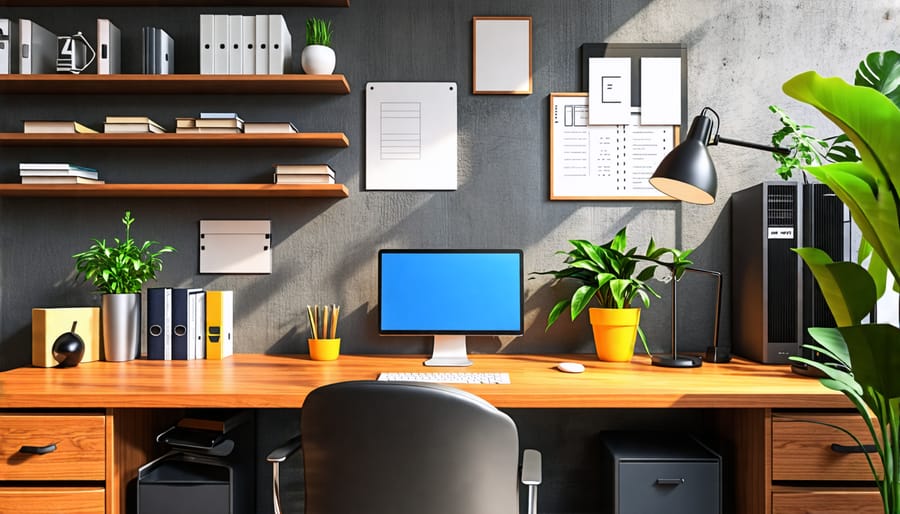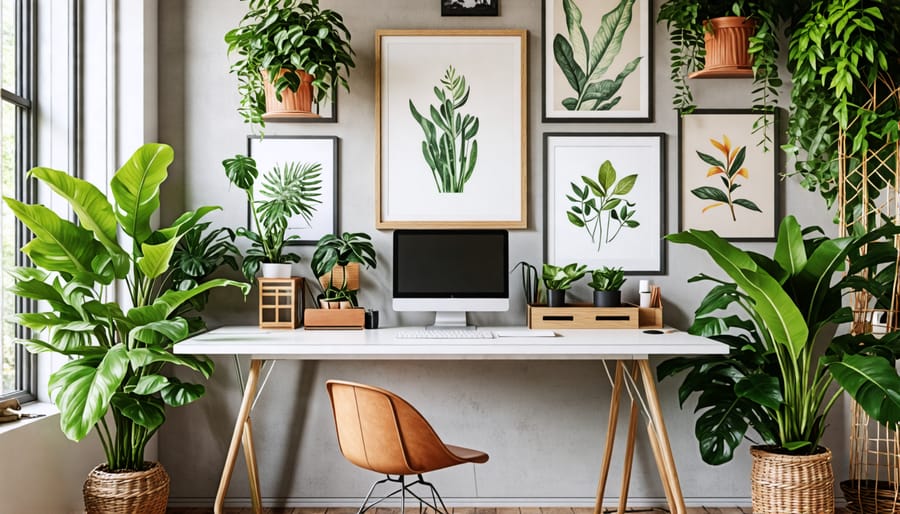Designate a dedicated workspace to boost focus and productivity. Choose a quiet, well-lit area with minimal distractions.
Invest in an ergonomic chair and properly adjusted desk to prevent physical strain during long work sessions. Position your screen at eye level.
Declutter regularly and implement an organizing system to maintain a tidy, efficient workspace. Everything should have a designated place.
Personalize your space with plants, inspiring artwork, or meaningful photos to create a pleasant atmosphere that motivates you. Design the perfect workspace that reflects your personality and enhances your well-being.
Choose the Right Location
Choosing the right location for your workspace is crucial for productivity and focus. Ideally, select a dedicated room or area in your home that offers privacy and quiet. If you’re working remotely, this might be a spare bedroom, a corner of the living room, or even a converted closet. The key is to create separation between your work life and personal life.
When evaluating potential spaces, consider factors like natural light, noise levels, and proximity to distractions. A room with a door that closes can help you maintain boundaries and minimize interruptions from family members or roommates. If possible, choose a location with a window to let in natural light and fresh air, which can boost your mood and energy levels.
Also, think about the physical layout of the space. You’ll want enough room for a comfortable desk and chair, as well as any additional equipment or storage you may need. If you have limited square footage, look for creative solutions like wall-mounted shelves or a compact desk that fits in a corner.
Remember, the goal is to create a space that feels separate from the rest of your home and allows you to focus on work. By being intentional about the location of your workspace, you’ll be better equipped to tackle your to-do list and maintain a healthy work-life balance.
Invest in Ergonomic Furniture

Prioritize a Quality Chair
Investing in a quality chair is crucial for both comfort and productivity in your workspace. Look for a chair that offers proper lumbar support to maintain a healthy posture and reduce back strain during extended sitting periods. Adjustable height is another key feature, allowing you to position the chair so that your feet rest flat on the floor and your thighs are parallel to the ground. This promotes better circulation and reduces pressure on your legs. Additionally, consider a chair with armrests to support your shoulders and prevent neck and upper back tension. While a quality chair may require a higher initial investment, it pays off in the long run by promoting physical well-being and enabling you to focus on your work without discomfort. Take the time to try out different options and find a chair that suits your body and working style.
Select the Right Desk
Selecting the right desk is crucial for both comfort and productivity. Consider a standing desk, which allows you to alternate between sitting and standing throughout the day, promoting better posture and reducing sedentary time. If a standing desk isn’t your preference, opt for a desk with ample surface area to accommodate your computer, documents, and any other essential tools. Make sure the desk height is appropriate for your body, allowing your elbows to rest at a 90-degree angle when typing. Don’t forget to choose a desk that complements your workspace’s overall style and aesthetic, creating a cohesive and inviting environment.
Optimize Lighting and Temperature
Optimizing lighting and temperature in your workspace can significantly impact your focus, productivity, and overall well-being. To create a well-lit environment, prioritize natural light by positioning your desk near a window. If natural light is limited, invest in high-quality desk lamps or overhead lighting that provides even illumination without glare. Consider using LED bulbs with adjustable color temperatures to customize your lighting based on the time of day and your preferences.
Maintain a comfortable temperature in your workspace, typically between 68-75°F (20-24°C). Too hot or too cold environments can lead to discomfort and distraction. If possible, install a programmable thermostat to automatically adjust the temperature throughout the day. For added comfort, use a small desk fan or space heater to fine-tune your personal temperature preferences.
Pay attention to the color temperature of your lighting, as it can affect your mood and energy levels. Cooler, blue-toned light can promote alertness and is ideal for tasks requiring concentration, while warmer, yellow-toned light creates a cozy atmosphere that’s better suited for relaxation or creative work. Experiment with different color temperatures to find what works best for you.
Finally, take regular breaks to rest your eyes and adjust your lighting as needed. Use the 20-20-20 rule: every 20 minutes, look at an object 20 feet away for at least 20 seconds. This helps reduce eye strain and maintain visual comfort throughout your workday.
Declutter and Organize
A cluttered workspace can hinder productivity and increase stress levels. To maintain a tidy and organized environment, start by decluttering your desk. Remove any unnecessary items and keep only the essentials within reach. Invest in smart storage solutions like desk organizers, filing cabinets, and shelving units to keep your materials and documents in order. Label your storage containers and folders for easy retrieval and a polished look.
Maximize vertical space by utilizing wall-mounted shelves or pegboards to store frequently used items, freeing up valuable desk space. Implement a cable management system to keep cords and wires tangle-free and out of sight. Consider using a cable tray or zip ties to bundle cables together neatly.
Develop a habit of regularly decluttering and reorganizing your workspace. Set aside a few minutes at the end of each day or week to tidy up, file away papers, and return items to their designated storage spots. This practice will help maintain a clutter-free environment and make it easier to find what you need when you need it.
Remember, a well-organized workspace not only enhances the aesthetic appeal of your home office but also contributes to improved focus, efficiency, and overall well-being. By implementing smart storage solutions and maintaining a tidy work area, you’ll create an environment that promotes productivity and reduces distractions, allowing you to tackle your tasks with greater clarity and purpose.

Incorporate Personal Touches
Personalize your workspace to boost motivation and create an uplifting atmosphere. Start by adding inspiring décor that reflects your personality and passions. Consider hanging motivational quotes, artwork, or photographs that bring you joy and encouragement. Introducing plants is another excellent way to enliven your space and promote a sense of well-being. Choose low-maintenance options like succulents or snake plants if you’re new to plant care.
To further make your home feel cozy and inviting, incorporate personal touches such as family photos, cherished mementos, or handmade items. These elements not only add visual interest but also provide a comforting connection to your loved ones and favorite memories. Remember, the goal is to create a space that inspires and motivates you, so don’t be afraid to experiment with different arrangements until you find the perfect balance. By surrounding yourself with meaningful and uplifting décor, you’ll cultivate a workspace that nurtures your creativity and enhances your overall well-being.

Prioritize Privacy and Noise Control
In a shared workspace or home office, distractions can quickly derail your productivity. Prioritizing privacy and noise control is essential for maintaining focus and minimizing interruptions. Consider using partitions or room dividers to create a sense of separation and reduce visual distractions. Noise-canceling headphones are a game-changer for those working in bustling environments, allowing you to immerse yourself in your tasks without being disturbed by ambient noise. Alternatively, incorporating white noise or nature sounds can help mask disruptive sounds and create a calming atmosphere. Experiment with different strategies to find the perfect balance of privacy and noise control that suits your needs and enhances your ability to concentrate on your work. Remember, a distraction-free workspace is key to unlocking your full potential and achieving your goals.
